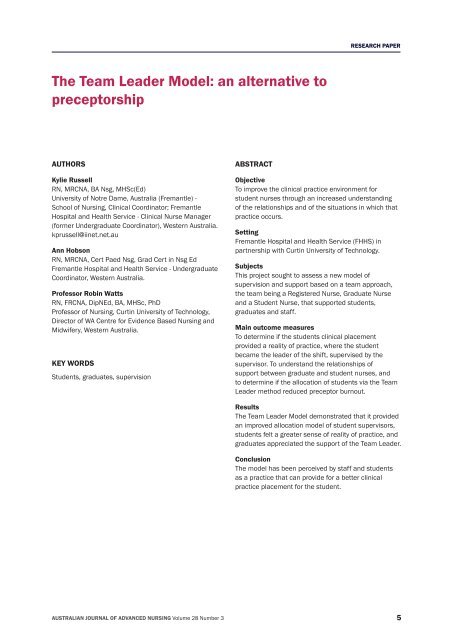australian journal of advanced nursing
australian journal of advanced nursing
australian journal of advanced nursing
Create successful ePaper yourself
Turn your PDF publications into a flip-book with our unique Google optimized e-Paper software.
The Team Leader Model: an alternative to<br />
preceptorship<br />
AUTHORS<br />
Kylie Russell<br />
RN, MRCNA, BA Nsg, MHSc(Ed)<br />
University <strong>of</strong> Notre Dame, Australia (Fremantle) ‑<br />
School <strong>of</strong> Nursing, Clinical Coordinator; Fremantle<br />
Hospital and Health Service ‑ Clinical Nurse Manager<br />
(former Undergraduate Coordinator), Western Australia.<br />
kprussell@iinet.net.au<br />
Ann Hobson<br />
RN, MRCNA, Cert Paed Nsg, Grad Cert in Nsg Ed<br />
Fremantle Hospital and Health Service ‑ Undergraduate<br />
Coordinator, Western Australia.<br />
Pr<strong>of</strong>essor Robin Watts<br />
RN, FRCNA, DipNEd, BA, MHSc, PhD<br />
Pr<strong>of</strong>essor <strong>of</strong> Nursing, Curtin University <strong>of</strong> Technology,<br />
Director <strong>of</strong> WA Centre for Evidence Based Nursing and<br />
Midwifery, Western Australia.<br />
KEY WORDS<br />
Students, graduates, supervision<br />
ABSTRACT<br />
RESEARCH PAPER<br />
Objective<br />
To improve the clinical practice environment for<br />
student nurses through an increased understanding<br />
<strong>of</strong> the relationships and <strong>of</strong> the situations in which that<br />
practice occurs.<br />
Setting<br />
Fremantle Hospital and Health Service (FHHS) in<br />
partnership with Curtin University <strong>of</strong> Technology.<br />
Subjects<br />
This project sought to assess a new model <strong>of</strong><br />
supervision and support based on a team approach,<br />
the team being a Registered Nurse, Graduate Nurse<br />
and a Student Nurse, that supported students,<br />
graduates and staff.<br />
Main outcome measures<br />
To determine if the students clinical placement<br />
provided a reality <strong>of</strong> practice, where the student<br />
became the leader <strong>of</strong> the shift, supervised by the<br />
supervisor. To understand the relationships <strong>of</strong><br />
support between graduate and student nurses, and<br />
to determine if the allocation <strong>of</strong> students via the Team<br />
Leader method reduced preceptor burnout.<br />
Results<br />
The Team Leader Model demonstrated that it provided<br />
an improved allocation model <strong>of</strong> student supervisors,<br />
students felt a greater sense <strong>of</strong> reality <strong>of</strong> practice, and<br />
graduates appreciated the support <strong>of</strong> the Team Leader.<br />
Conclusion<br />
The model has been perceived by staff and students<br />
as a practice that can provide for a better clinical<br />
practice placement for the student.<br />
AUSTRALIAN JOURNAL OF ADVANCED NURSING Volume 28 Number 3 5

















